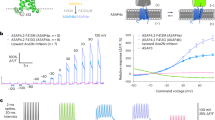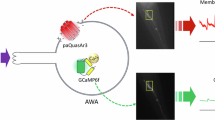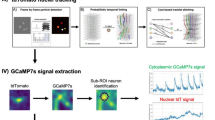Abstract
Genetically encoded calcium indicators (GECIs) can be used to image activity in defined neuronal populations. However, current GECIs produce inferior signals compared to synthetic indicators and recording electrodes, precluding detection of low firing rates. We developed a single-wavelength GCaMP2-based GECI (GCaMP3), with increased baseline fluorescence (3-fold), increased dynamic range (3-fold) and higher affinity for calcium (1.3-fold). We detected GCaMP3 fluorescence changes triggered by single action potentials in pyramidal cell dendrites, with signal-to-noise ratio and photostability substantially better than those of GCaMP2, D3cpVenus and TN-XXL. In Caenorhabditis elegans chemosensory neurons and the Drosophila melanogaster antennal lobe, sensory stimulation–evoked fluorescence responses were significantly enhanced with GCaMP3 (4–6-fold). In somatosensory and motor cortical neurons in the intact mouse, GCaMP3 detected calcium transients with amplitudes linearly dependent on action potential number. Long-term imaging in the motor cortex of behaving mice revealed large fluorescence changes in imaged neurons over months.
This is a preview of subscription content, access via your institution
Access options
Subscribe to this journal
Receive 12 print issues and online access
$259.00 per year
only $21.58 per issue
Buy this article
- Purchase on SpringerLink
- Instant access to full article PDF
Prices may be subject to local taxes which are calculated during checkout






Similar content being viewed by others
References
Yuste, R., Peinado, A. & Katz, L.C. Neuronal domains in developing neocortex. Science 257, 665–669 (1992).
Stosiek, C., Garaschuk, O., Holthoff, K. & Konnerth, A. In vivo two-photon calcium imaging of neuronal networks. Proc. Natl. Acad. Sci. USA 100, 7319–7324 (2003).
Fetcho, J.R., Cox, K.J. & O'Malley, D.M. Monitoring activity in neuronal populations with single-cell resolution in a behaving vertebrate. Histochem. J. 30, 153–167 (1998).
Tour, O. et al. Calcium Green FlAsH as a genetically targeted small-molecule calcium indicator. Nat. Chem. Biol. 3, 423–431 (2007).
Palmer, A.E. & Tsien, R.Y. Measuring calcium signaling using genetically targetable fluorescent indicators. Nat. Protocols 1, 1057–1065 (2006).
Mank, M. et al. A genetically encoded calcium indicator for chronic in vivo two-photon imaging. Nat. Methods 5, 805–811 (2008).
McCombs, J.E. & Palmer, A.E. Measuring calcium dynamics in living cells with genetically encodable calcium indicators. Methods 46, 152–159 (2008).
Mank, M. & Griesbeck, O. Genetically encoded calcium indicators. Chem. Rev. 108, 1550–1564 (2008).
Baird, G.S., Zacharias, D.A. & Tsien, R.Y. Circular permutation and receptor insertion within green fluorescent proteins. Proc. Natl. Acad. Sci. USA 96, 11241–11246 (1999).
Nagai, T., Sawano, A., Park, E.S. & Miyawaki, A. Circularly permuted green fluorescent proteins engineered to sense Ca2+. Proc. Natl. Acad. Sci. USA 98, 3197–3202 (2001).
Miyawaki, A. et al. Fluorescent indicators for Ca2+ based on green fluorescent proteins and calmodulin. Nature 388, 882–887 (1997).
Heim, N. & Griesbeck, O. Genetically encoded indicators of cellular calcium dynamics based on troponin C and green fluorescent protein. J. Biol. Chem. 279, 14280–14286 (2004).
Palmer, A.E. et al. Ca2+ indicators based on computationally redesigned calmodulin-peptide pairs. Chem. Biol. 13, 521–530 (2006).
Wallace, D.J. et al. Single-spike detection in vitro and in vivo with a genetic Ca2+ sensor. Nat. Methods 5, 797–804 (2008).
He, J., Ma, L., Kim, S., Nakai, J. & Yu, C.R. Encoding gender and individual information in the mouse vomeronasal organ. Science 320, 535–538 (2008).
Chalasani, S.H. et al. Dissecting a circuit for olfactory behaviour in Caenorhabditis elegans. Nature 450, 63–70 (2007).
Wang, J.W., Wong, A.M., Flores, J., Vosshall, L.B. & Axel, R. Two-photon calcium imaging reveals an odor-evoked map of activity in the fly brain. Cell 112, 271–282 (2003).
Akerboom, J. et al. Crystal structures of the GCaMP calcium sensor reveal the mechanism of fluorescence signal change and aid rational design. J. Biol. Chem. 284, 6455–6464 (2008).
Wang, Q., Shui, B., Kotlikoff, M.I. & Sondermann, H. Structural basis for calcium sensing by GCaMP2. Structure 16, 1817–1827 (2008).
Hires, S.A., Tian, L. & Looger, L.L. Reporting neural activity with genetically encoded calcium indicators. Brain Cell Biol. 36, 69–86 (2008).
Varshavsky, A. The N-end rule at atomic resolution. Nat. Struct. Mol. Biol. 15, 1238–1240 (2008).
Pedelacq, J.D., Cabantous, S., Tran, T., Terwilliger, T.C. & Waldo, G.S. Engineering and characterization of a superfolder green fluorescent protein. Nat. Biotechnol. 24, 79–88 (2006).
Pologruto, T.A., Yasuda, R. & Svoboda, K. Monitoring neural activity and [Ca2+] with genetically encoded Ca2+ indicators. J. Neurosci. 24, 9572–9579 (2004).
Mao, T., O'Connor, D.H., Scheuss, V., Nakai, J. & Svoboda, K. Characterization and subcellular targeting of GCaMP-type genetically-encoded calcium indicators. PLoS ONE 3, e1796 (2008).
Hendel, T. et al. Fluorescence changes of genetic calcium indicators and OGB-1 correlated with neural activity and calcium in vivo and in vitro. J. Neurosci. 28, 7399–7411 (2008).
Markram, H., Helm, P.J. & Sakmann, B. Dendritic calcium transients evoked by single back-propagating action potentials in rat neocortical pyramidal neurons. J. Physiol. (Lond.) 485, 1–20 (1995).
Shepherd, G.M. & Svoboda, K. Laminar and columnar organization of ascending excitatory projections to layer 2/3 pyramidal neurons in rat barrel cortex. J. Neurosci. 25, 5670–5679 (2005).
Dombeck, D.A., Khabbaz, A.N., Collman, F., Adelman, T.L. & Tank, D.W. Imaging large-scale neural activity with cellular resolution in awake, mobile mice. Neuron 56, 43–57 (2007).
Ferkey, D.M. et al. C. elegans G protein regulator RGS-3 controls sensitivity to sensory stimuli. Neuron 53, 39–52 (2007).
Jayaraman, V. & Laurent, G. Evaluating a genetically encoded optical sensor of neural activity using electrophysiology in intact adult fruit flies. Front Neural Circuits 1, 3 (2007).
Kim, S.G. & Ogawa, S. Insights into new techniques for high resolution functional MRI. Curr. Opin. Neurobiol. 12, 607–615 (2002).
Hasan, M.T. et al. Functional fluorescent Ca2+ indicator proteins in transgenic mice under TET control. PLoS Biol. 2, e163 (2004).
Garaschuk, O., Griesbeck, O. & Konnerth, A. Troponin C–based biosensors: a new family of genetically encoded indicators for in vivo calcium imaging in the nervous system. Cell Calcium 42, 351–361 (2007).
Kotlikoff, M.I. Genetically encoded Ca2+ indicators: using genetics and molecular design to understand complex physiology. J. Physiol. (Lond.) 578, 55–67 (2007).
Gray, N.W., Weimer, R.M., Bureau, I. & Svoboda, K. Rapid redistribution of synaptic PSD-95 in the neocortex in vivo. PLoS Biol. 4, e370 (2006).
Saito, T. & Nakatsuji, N. Efficient gene transfer into the embryonic mouse brain using in vivo electroporation. Dev. Biol. 240, 237–246 (2001).
Shaner, N.C. et al. Improved monomeric red, orange and yellow fluorescent proteins derived from Discosoma sp. red fluorescent protein. Nat. Biotechnol. 22, 1567–1572 (2004).
Markstein, M., Pitsouli, C., Villalta, C., Celniker, S.E. & Perrimon, N. Exploiting position effects and the gypsy retrovirus insulator to engineer precisely expressed transgenes. Nat. Genet. 40, 476–483 (2008).
Thiel, G., Greengard, P. & Sudhof, T.C. Characterization of tissue-specific transcription by the human synapsin I gene promoter. Proc. Natl. Acad. Sci. USA 88, 3431–3435 (1991).
Stoppini, L., Buchs, P.A. & Muller, D. A simple method for organotypic cultures of nervous tissue. J. Neurosci. Methods 37, 173–182 (1991).
Brand, A.H., Manoukian, A.S. & Perrimon, N. Ectopic expression in Drosophila. Methods Cell Biol. 44, 635–654 (1994).
Wilson, R.I. & Laurent, G. Role of GABAergic inhibition in shaping odor-evoked spatiotemporal patterns in the Drosophila antennal lobe. J. Neurosci. 25, 9069–9079 (2005).
Huber, D. et al. Sparse optical microstimulation in barrel cortex drives learned behaviour in freely moving mice. Nature 451, 61–64 (2008).
Hippenmeyer, S. et al. A developmental switch in the response of DRG neurons to ETS transcription factor signaling. PLoS Biol. 3, e159 (2005).
Petreanu, L., Huber, D., Sobczyk, A. & Svoboda, K. Channelrhodopsin-2–assisted circuit mapping of long-range callosal projections. Nat. Neurosci. 10, 663–668 (2007).
Acknowledgements
We thank J. Simpson and S. Hampel for cloning GCaMPs into pMUH, and members of the Fly Core for making fly crosses. pMUH was a generous gift from B. Pfeiffer and G. Rubin. We thank J. Seelig, who contributed to the Drosophila imaging experiments, S. Viswanathan and S. Sternson for assistance in screening mutants in HEK293 cells, J. Marvin for assistance in screening mutants in Escherichia coli, B. Zemelman for assistance in virus production, H. Zhong, T. Sato and B. Borghuis for developing image analysis software, D.K. O'Connor for assistance with in utero electroporation, H. White and S. Winfrey for cell culture, B. Shields and A. Hu for immunostaining, A. Arnold for helping with imaging experiments, members of the Molecular Biology Shared Resource for plasmid preparation and sequencing, and J. Marvin, J. Simpson and G. Tervo for critical reading of the manuscript. All affiliations are Howard Hughes Medical Institute, Janelia Farm Research Campus. GCaMP2 plasmid was a gift from M. Kotlikoff (Cornell University); TN-XXL plasmid was a gift from O. Griesbeck (Max Planck Institute of Neurobiology); D3cpVenus plasmid was a gift from A. Palmer (University of Colorado); GH146-Gal4 flies were a gift from L. Luo (Stanford University); UAS-GCaMP1.6 flies were a gift from D. Rieff and A. Borst (Max Planck Institute of Neurobiology).
Author information
Authors and Affiliations
Contributions
L.L.L., K.S., L.T., S.A.H. and T.M. designed the project; L.T. and L.L.L. designed the sensor and screen in E. coli and HEK293 cells; L.T., T.M., S.A.H. and L.P. tested the GCaMP variant in brain slice; S.A.H. tested FRET sensor and GCaMP2 in brain slice; S.A.H., L.T. and D.H. analyzed imaging data of brain slice and in vivo; D.H. performed in vivo mouse brain imaging; S.H.C. and C.I.B. performed worm imaging and data analysis; V.J. and M.E.C. performed calcium imaging and data analysis in the fly; S.A.M. and S.A.H. analyzed data for AP detection probability; J.A., L.L.L. and E.R.S. analyzed the structure; L.L.L. and L.T. led the project; L.L.L., K.S., L.T. and S.A.H. wrote the paper.
Corresponding author
Supplementary information
Supplementary Text and Figures
Supplementary Figures 1–12 and Supplementary Tables 1–3 (PDF 7089 kb)
Supplementary Movie 1
Spontaneous neural activity visualized by GCaMP2 in cultured hippocampal brain slice (3× real time) (MOV 7960 kb)
Supplementary Movie 2
Spontaneous neural activity visualized by GCaMP3 in cultured hippocampal brain slice (3× real time) (MOV 9095 kb)
Supplementary Movie 3
Naturally occurring activity of populations of layer 2/3 neurons expressing GCaMP3 in the primary motor cortex (M1) of awake, behaving mouse during 140 s sequence of two-photon images (10× real time) (AVI 7773 kb)
Rights and permissions
About this article
Cite this article
Tian, L., Hires, S., Mao, T. et al. Imaging neural activity in worms, flies and mice with improved GCaMP calcium indicators. Nat Methods 6, 875–881 (2009). https://doi.org/10.1038/nmeth.1398
Received:
Accepted:
Published:
Issue Date:
DOI: https://doi.org/10.1038/nmeth.1398
This article is cited by
-
Video-based pooled screening yields improved far-red genetically encoded voltage indicators
Nature Methods (2023)
-
Adenosine-independent regulation of the sleep–wake cycle by astrocyte activity
Cell Discovery (2023)
-
Why study sleep in flatworms?
Journal of Comparative Physiology B (2023)



